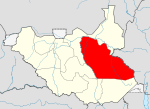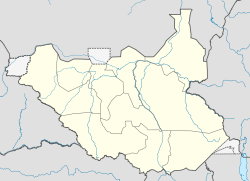- Fangak County
-
Fangak County Location in South Sudan Coordinates: 9°04′10″N 30°53′03″E / 9.06944°N 30.88417°ECoordinates: 9°04′10″N 30°53′03″E / 9.06944°N 30.88417°E Country  South Sudan
South SudanState Unity State Government – County Commissioner James Maluit Ruei[1] Population (2008) – Total 110,130 Fangak County is an administrative area in the north of Jonglei state, South Sudan, with headquarters in the town of Fam al Zaraf.[2]
Contents
Location
The county is located between Guit County in Unity State to the west, Ayod County to the south, Piji County to the east, Panyikang County of Upper Nile State in the northeast, and Ruweng County in the north. Fam al Zaraf town, the county headquarters, lies where the Bahr el Zeraf enters the White Nile from the east.[2] The Zeraf island, in which the town of Old Fangak is located, comprises a large part of the county. The island, much of which is within the Block 5A oilfield, is between the White Nile, or Bahr el Jebel, to the west and the Bahr el Zeraf to the east.[3]
People
The 2008 census estimated that the population of the county was 110,130. Most of the inhabitants of Fangak County belong to the Laak and Thiang sections of the Nuer people. The people are agro-pastoralist, growing crops for personal use and for sale by traditional agricultural techniques and raising cattle. Cattle are central to the culture, exchanged in marriages, and provide milk, meat and hides.[2]
Security issues
In February 2011, forces loyal to the rebel General George Athor attacked three operational outposts of the Sudan People's Liberation Army (SPLA). They briefly occupied the town of Fangak before withdrawing when SPLA troops arrived. Several people died in the conflict.[4] Later the SPLA reported that at least 105 people had been killed, mostly women and children. UN Secretary General Ban Ki-Moon, called for immediate implementation of the January ceasefire agreement.[5] In June 2011 James Maluit Ruach, Commissioner of Fangak County, said that the security situation was under control but that Athor's forces had sown land mines, which urgently needed to be cleared.[6]
References
- ^ "Jonglei". Embassy of South Sudan in Washington. http://www.gossmission.org/goss/index.php?option=com_content&task=view&id=34&Itemid=37. Retrieved 2011-08-07.
- ^ a b c Paulino G. Kedok (June 7, 2011). "Fangak County should be annexed to Upper Nile State". South Sudan News Agency. http://www.southsudannewsagency.com/opinion/articles/fangak-county-should-be-annexed-to-upper-nile-state. Retrieved 2011-08-07.
- ^ Jemera Rone (2003). Sudan, oil, and human rights. Human Rights Watch. pp. 316–317. ISBN 1564322912. http://books.google.ca/books?id=3WQkACoP3FkC&pg=PA316.
- ^ Ngor Arol Garang (February 10, 2011). "South Sudan army retake Fangak from Athor forces -SPLA". Sudan Tribune. http://www.sudantribune.com/South-Sudan-army-retake-Fangak,37955. Retrieved 2011-08-07.
- ^ Julius N. Uma (February 13, 2011). "Human rights body condemns Jonglei killings, calls for urgent action". Sudan Tribune. http://www.sudantribune.com/Human-rights-body-condemns-Jonglei,37980. Retrieved 2011-08-07.
- ^ Philip Thon Aleu (21 June 2011). "Jonglei State - Landmines Threaten Resettlement in Fangak". Sudan Tribune. http://allafrica.com/stories/201106230968.html. Retrieved 2011-08-07.
State capital: BorCounties Twic East · Duk · Bor South · Bor North · Akobo · Nyirol · Uror · Pibor · Pochalla · Ayod · Pigi · Fangak · Khorfulus
Populated places Akobo · Ayod · Bor · Faddoi · Greater Fangak · Kongor · Lith Payam · Panyagor · Pibor · Pochalla · Waat · Wernyol CityUniversities Akobo Heritage and Memorial UniversityAirports Akobo Airport · Bor Aiport · Pibor Airport · Pochalla AirportOther Bor DistrictCategories:- Counties of South Sudan
- Counties of Jonglei
Wikimedia Foundation. 2010.

